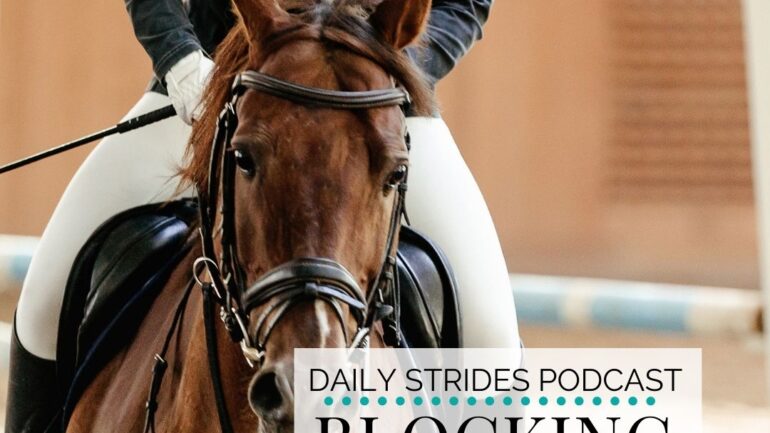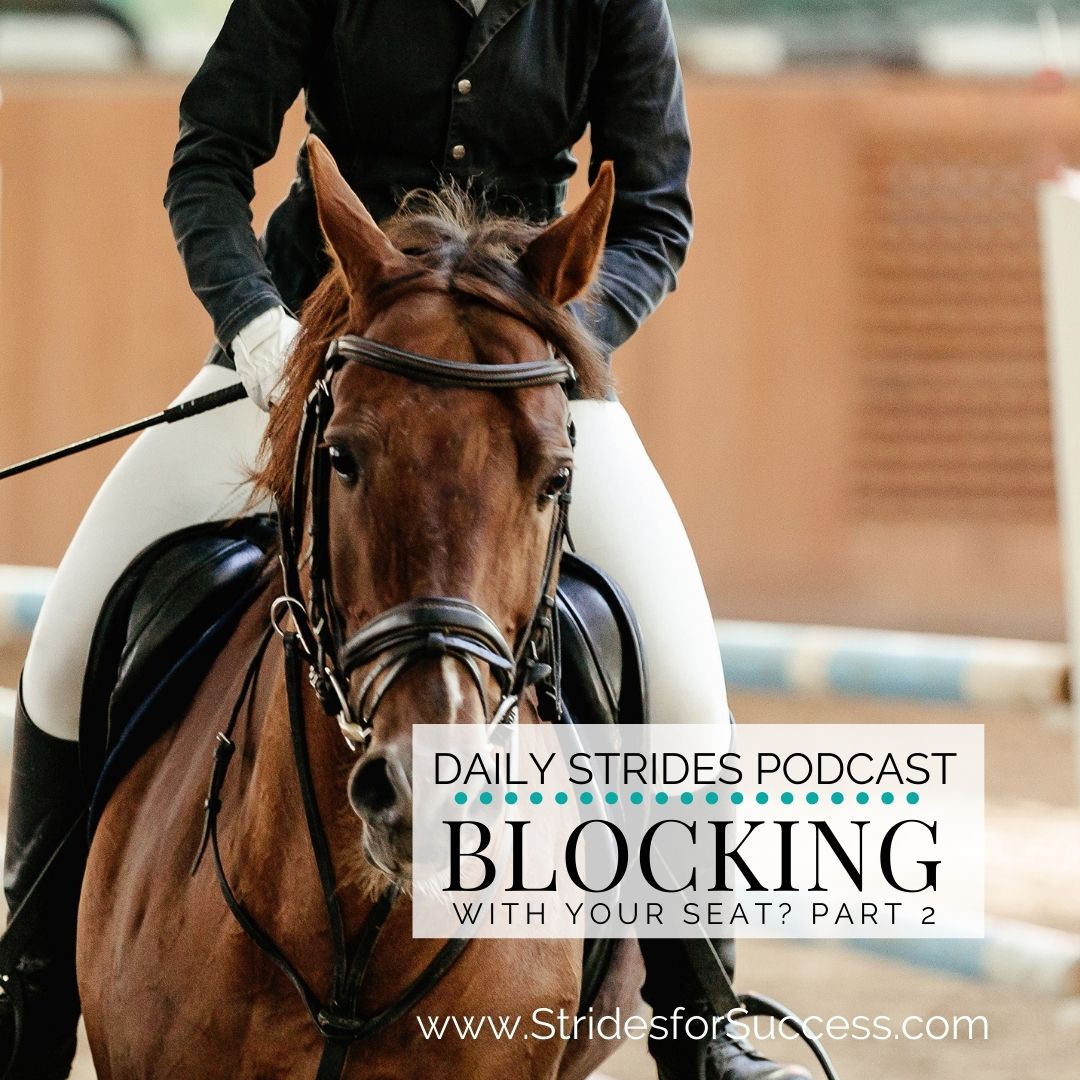Are you guilty of saying one thing to your horse, when you actually mean another? You’re not alone! This is the second part of a 2 part series all about blocking with your seat, and how to stop doing it! Part 1 is HERE
Before we dive into the actual riding exercises you can do to discover if you have been blocking. And then, using those same exercises to actually begin allowing. Let’s get clear on what we mean when we say ‘blocking’.
Blocking is when you mean to say ‘carry on’, but instead you say ‘whoa’. It is applying the resisting force of your seat when you actually want to simply allow your horse to really move your seat.
Exercise 1:- Allowing in the Walk
A lot can be learned about your influence on your horse in the walk. Slight changes and tweaks to what you are doing can have a big and, very important, noticeable impact on your horse’s way of going. Use this to your advantage and test yourself…
In halt, take both feet out of your stirrups. From here, ask your horse to walk forward. Your goal is to simply follow your horse with your seat. Like dancing. Your horse is the lead partner. You are literally a split second ‘behind’ your horse’s movement and yet moving with him – not being dragged!
As your horse walks, pay close attention to the rhythm of the walk and how much ground he is covering with each stride.
From here, notice which leg is moving when underneath you. Your left seat bone will dip down (lower) and move forwards when your horses left hind leg is in the air and moving forwards. When this is happening, your right seat bone will rise up and move backward. This corresponds with your horse’s right hind foot being on the ground and his body moving over it.
Get To Know Your ‘Gears’
As mentioned in the previous episode and blog post HERE, you have 3 basic ways you can use your seat when riding. Go, whoa, and neutral. You can ask for ‘more’, you can steady or slow things down, or you can affirm what your horse is doing and tell him to ‘carry on’.
Begin playing with the ‘three gears’ of your seat. Go, whoa, and neutral. Driving, resisting, and allowing.
Go versus Neutral
Start with ‘go’ first. Again, notice the movement of your seat and how this corresponds with your horse’s hind legs. Remember that when asking for more, there can be a temptation to ‘drive’. As in, dig a hole! Resist this temptation! Simply think about ‘encouraging’ your horse forward a little more through the energy of your seat.
Go will not be used all the time. Riders begin ‘driving’ when they confuse ‘go’ and ’neutral’. They confuse driving and allowing.
You will only say ‘go’ when you either need to add more energy or you are changing what you are doing. Riding in ‘go’ or driving for the entire ride will result in your horse ignoring your aids. This then results in the rider doubling down on their efforts. Go is not allow!
Whoa versus Neutral
From here, play with resisting. Again, it is often easiest to begin this by thinking of a swing and how you would ‘stop’ the swing with your body. Like go, whoa is only used when you are either balancing or changing what you are doing. Otherwise, you should, again, ride in neutral.
Blocking occurs when riders are riding the whole ride, or a vast proportion of it, in whoa.
Playing with Your Gears in Walk
Once you can feel how each ‘gear’ feels in the walk, begin playing with them. Be intentional about when and how you use them. Notice what influence each ‘gear’ has over your horse’s way of going.
As with all aids, your seat aid will not just ‘stand-alone’ when you use it.
Notice the balance of your seat aid with your other aids and how you can begin tweaking the pressure, the sequence, and the timing of each aid. Also, play with which aid has a ‘lead role’ and which has a supporting role in each question you ask of your horse. All horses are different. Therefore each horse will respond to your aids in a slightly different way.
Dedicate time to discovering which aids your horse prefers when communicating, and then begin refining those aids.
Exercise 2:- The Sitting Trot
Oh, this one is a biggie when it comes to riders. In my experience, the more movement in a rider’s upper body when riding the sitting trot, the more likely they are blocking with their seat. This is usually the case for canter as well.
Many riders learn early on that the easiest way to avoid being bounced around in sitting trot is to ‘hunker down’.
They collapse their upper body completely. So much that it literally squashes their seat area (belly button to upper thighs), in an attempt to stop bouncing around in the saddle as the horse moves. When the horse is moving slowly or with no energy or forwardness, you will get away with this. It is probably the ‘easiest way’ to ride the sitting trot.
However, the issues begin to appear when more energy is put into the container that makes up horse and rider. When more ‘swing’ is required. More suppleness.
The literal ‘heaviness’ of the collapsed upper body will block the lower torso from moving, and in doing so, block the horse.
Start with Carrying Yourself
I mentioned in the previous episode and blog post that the term ‘sitting’ in the saddle is a confusing one. Yes, you are technically sitting. However, your core should feel more like you’re standing. It should be engaged and carrying you.
Begin in a slow sitting trot that is perhaps lacking the forwardness it should have. Work on carrying your upper body. Simply put, create space between your lower ribcage and your pelvis or hips. Elongate your body.
As your horse moves, notice that your seat (belly button to upper thighs) moves like a hinge, rather than simply up and down.
We often think of up and down in trot because most riders are introduced to trot and trotting with the words up and down being used a lot to encourage posting or rising. However, as we begin to create a more independent seat, we notice that it is less upend down and rather forward and back. Like a hinge.
What is important to notice is that your lower torso, your seat, is doing the moving. Not your upper body, your shoulders, and chest.
Play with Your Gears
From here, begin experimenting with the same 3 basic gears. Go, whoa, and neutral. Work on go first. It is often the one most riders are familiar with. Remember not to drive, but to simply ask a question. Driving is, again, when you are saying go all the time. It is when you get stuck in the ‘go’ gear!
Then play with whoa. Resisting. Notice how you will only resist for a split second and then allow again. To continually resist will cause the tension level, or relaxation, to change to where it is no longer useful for you and your horse. For some horses, they become frustrated, excessive tension. For others, they simply do what you ask and slow down or stop, inadequate tension.
The goal is to simply ‘allow’ your horse to work forward while you remain in the sitting trot. To move with your horse, rather than pushing or pulling with your seat.
Exercise 3:- The Canter
I know, I said two exercises, but this one is also a great one for really showing you if you’re guilty of blocking with your seat while cantering. Take a video of yourself. Focus on the canter itself. I would suggest cantering a 20m circle or similar for two or three circuits. This is long enough to really see what happens when you ‘get going’ in the canter.
When you watch it, notice if you’re guilty of some questionable 1980s style shoulder movements while riding the canter.
For many riders, the first few strides are good. They allow through the transition into a canter and move with the horse. However, then they feel that they have to ‘do something’. And this is where all that upper body movement begins. Lots of ducking and, often, swinging with one shoulder ahead of the other. Like the ‘Dem Bones’ song goes “Hip bone connected to the backbone, Backbone connected to the shoulder bone”.
The shoulder movement is happening because the hips are blocking the energy. And the energy has to go somewhere!
As soon as you begin noticing your shoulders ‘swinging’, think about firstly carrying your upper body. Engage your core just like you would while standing. From there, focus on allowing your seat to move and your shoulders remaining ‘still’. Obviously, you are on a horse and moving. They are not going to be completely stationary. However, they won’t be ‘swinging’.
Finally, work on then allowing your hands to literally follow your seat. So that your seat and hands are following your horse…
Allowing With Your Seat
Allowing or neutral is so important to understand in your riding. It is also a place where bad habits can creep in and then negatively influence all areas of your riding. Learn to pay attention to your horse’s rhythm and the amount of ground he is covering with each stride. They will show you the influence you are having over him using your seat.
By clearly identifying the driving and resisting (go and whoa), you will begin to more clearly identify neutral.
And remember, you will spend the most time in neutral… The others are simply to ask questions or to correct.
Happy Riding
Lorna
Additional Resources on This Topic
-
-
- Learning to Stop Blocking with Your Seat – Part 1
- Learn to Stop Driving with Your Seat
- Connection in Your Riding; Seat and Legs
- Your Independent Seat is a Result of Your Independent Aids
- Your Independent Seat is Everything in Your Riding
- Improving Your Feel in the Saddle
- DEVELOP YOUR AIDS THROUGH LUNGING – UPCOMING FREE ONLINE LIVE TRAINING
- Online coaching and audio horse riding lessons for equestrians
- Groundwork for Riding
- Online community for equestrians working on their mindset & fitness
- Online Community for equestrians focusing on re-schooling horses (and ex-racehorses)
- The Daily Strides Podcast on iTunes
- The Daily Strides Podcast on Stitcher Radio
-


